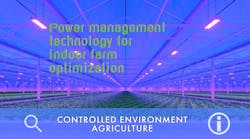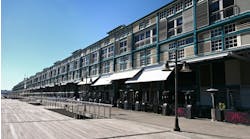A growing number of architects and engineers are advocating for indoor farm and greenhouse designs that use centralized direct current (DC) power, because it greatly expands a farmer’s ability to optimize energy efficiency, operational flexibility, production quality, and the physical design of a farm.
In this article, I begin by discussing the advantages of centralized DC power with a specific focus on horticulture LEDs because they use by far the most power in an indoor farm. I also explain why centralized DC power design hasn’t yet been widely adopted, despite the advantages. Lastly, I explain why this will change because of a new development in power distribution technology that makes centralized DC power practical and creates even more benefits.
What is centralized DC power?
With a centralized DC power design, AC power is converted to DC power in one central location, like an electrical room, instead of at each device. For example, in a traditional AC installation each LED fixture employs an individual driver. In a centralized DC power architecture, the DC power is converted from the AC power source in the electrical room to DC, and then distributed to driverless LEDs in the grow space. The change is subtle, but it removes constraints to unlock optimization opportunities. With more and more devices running on DC power in a modern farm, the centralized DC model can help optimize farm performance.
Advantages of centralized DC power
Increased reliability and resiliency. AC-based designs require hundreds or thousands of power supplies installed in the worst place for active electronics — wet grow spaces that experience extreme temperature fluctuations. Centralized DC power moves the power supplies into spaces designed for housing electrical components, thereby increasing power-supply lifetime while dramatically reducing the total number of components.
Greenseal Cannabis in Ontario, Canada, was one of the earliest adopters of centralized DC power. Its facility design replaced thousands of small LED power supplies with a few large devices in the electrical room, resulting in approximately 70% fewer electrical components than a traditional design. Since the LED power supply is the single most common point of failure, the reduction in system components significantly improved reliability and resiliency. Moreover, software can be deployed to diagnose any problem and immediately notify an in-house technician to fix it without entering the grow space. In a conventional AC design, someone must first see a dead LED fixture before calling in an electrician to enter the production space to diagnose and repair or replace the grow light; this not only disrupts production but increases biosecurity risk.
Improved ability to integrate renewables. Centralized DC power also affords operators the ability to integrate renewable energy sources more easily. Most renewable energy sources — such as solar panels, wind turbines, and batteries — deliver DC power. Using centralized DC power, buildings can directly connect to these sources without an AC-DC converter. By avoiding the conversion process, more energy from the renewable sources can be used directly by the building for a more sustainable and cost-effective site.
Improved growing conditions. From a physical layout perspective, power supplies disturb and restrict airflow inside grow spaces, increasing the number of small pockets of different temperatures and humidity — called microclimates — and making it harder to achieve consistent product quality. Each power supply also generates heat, which makes cooling the space more expensive. Moreover, when power supplies are near the LEDs, placing fixtures in the best location for the plants to receive optimal light for photosynthesis can be harder. Removing power supplies creating a consistent climate and providing good light distribution for plants easier and less expensive.
Easier washdowns. A significant challenge facing indoor farms is how pathogen populations grow and impact crop quality. If every part of the grow room isn’t regularly and thoroughly washed, the population of harmful microorganisms will increase. This will eventually cause declines in yields and quality.
However, placing LED power supplies and other electrical components around plants makes it difficult to carry out a thorough washdown. Again, since centralized DC power removes most of these components, conducting a full washdown of the grow room becomes easier.
In the future, the design standard for indoor farms must include rooms that can be fully washed down to prevent pathogen buildup.
Obstacles to centralized DC design
Until recently, the only way for indoor and greenhouse farmers to centralize DC power was to install traditional bulk AC-DC power supplies in an electrical room and then distribute the high-voltage DC power to LEDs. However, distributing power from traditional bulk power supplies requires specialized equipment including DC-rated breakers, relays, and other components, which cost more to install and maintain than traditional AC systems; they also can be difficult to find.
For example, the National Electrical Code requires ground-fault circuit interrupters (GFCIs) for LED lights installed in grow spaces. However, getting GFCIs for high-voltage DC is tough. So growers would need to hardwire their LEDs, contributing to delays and the higher cost of hiring an electrician to repair any issues that arise. These operational constraints and the need for specialized equipment have made using traditional bulk power supplies less appealing for growers.
These constraints have led to a new solution to centralize DC power in a simpler, more cost-effective manner for indoor and greenhouse operations.
Fault-managed power paves the way
A new technology called “fault-managed power” streamlines the distribution of high-voltage DC power without specialized safety equipment and wiring methods required for traditional AC-DC power supplies. Benefits include reduced initial and ongoing costs as well as improved electrical efficiency, device control, and safety compared to traditional AC systems.
Simply put, fault-managed power uses intelligence to manage the amount of power that is released into a fault. It protects people and equipment by using sensors and software to identify faults, such as a person touching an exposed wire. When such a condition is detected, the system quickly shuts off power, releasing only a tiny amount of power that is not enough to injure a person.
Digital Electricity, a technology invented by VoltServer, is a high-voltage power distribution product with advanced safety features. It is classified as a Limited Power Source (LPS) under the National Electric Code, which means it can be installed using the same wiring methods used for Ethernet cables, eliminating the need for complex, expensive electrical equipment and wiring methods.
The top panel of the nearby illustration demonstrates a traditional AC power distribution scheme for a grow room’s LEDs. The farm’s 480VAC feed is stepped down since GFCIs are more readily available for 208VAC. The stepped-down power is then distributed through a relay to receptacles in the grow space that deliver power to AC-DC supplies. Power supplies, receptacles, and other electrical components (not shown in the figure) must be installed in the grow room or greenhouse.
The bottom panel of the figure shows how Digital Electricity can simplify the design. A high-voltage AC feed is converted into high-voltage DC using devices called transmitters. The DC power is then pulsed 500 times per second with a short pause after each pulse. This pause allows the system to check for faults, and if there are no issues, the next pulse is sent. If a fault is detected, the system stops sending power to limit shock and fire hazards. The safety checks are what allow the system to be classified as an LPS, enabling farmers to distribute high-voltage DC directly to driverless LEDs using 75% less equipment and labor compared to traditional AC systems.
Energy efficiency, flexibility, and safety benefits
With Digital Electricity employed in CEA power schemes, higher voltage levels mean less electricity is lost during distribution, thereby improving energy efficiency. Managing heat generated by LED power supplies in a dry room also requires less energy from HVAC systems than in the humid growing environment. Finally, larger power supplies can be less expensive and more efficient than many smaller devices.
Operational flexibility has increased, according to user testimonials. The system safety feature allows growers to control, monitor, and schedule individual 600W LED groups, which would be far more expensive with traditional AC design. Halton Peters, president at certified organic vertical farm Hardee Fresh, Wauchula, Fla., explained that using remote DC power enabled with Digital Electricity “provides a superior opportunity to have control of our lights and our other IT infrastructure … . It’s the most energy-efficient way to manage large numbers of lights.”
A high level of flexibility is especially important in an emerging market like indoor farming because sales and marketing professionals still do not have good models for predicting consumer demand. Operators frequently and rapidly change the crop and inputs, increasing the value of using a fault managed power system.
According to Jamie Schurmans, who led farm construction and design teams at both Canopy Growth and InFarms and is now a principal at EFI Engineering in Ontario, “Indoor cultivation, especially when considering different crops and environmental requirements, necessitates constant adjustment to the physical and environmental growing conditions. Fault managed power provides a low-cost and reliable solution that is washdown compliant and reduces localized heat sources. Our clients find the inherently safe design easy to manipulate and rearrange using their own inhouse labor.”
Ontario-based GreenSeal Cannabis facility manager Chris Murray explained, “Not having all these rigid conduits and high-voltage power in there … we’re able to do a semi-permanent installation with VoltServer that can change at a moment’s notice,” which also improves the company’s speed to market.
Safety is the most important feature of a fault managed power system when handling high levels of electricity in complex, wet locations. With many new entrants to controlled environment agriculture, the risks of electrical shock are not always widely considered. Although the U.S. Bureau of Labor Statistics doesn’t report statistics for each industry, a total of 1,940 electrical injuries and 160 deaths occurred in the United States in 2020. That same year, an employee in an Ontario greenhouse was killed by electrocution. “Keeping AC out of the grow space gives us good peace of mind,” said Clint Hunnicutt, general manager at Hardee Fresh. “We use thousands and thousands of gallons of water through our building every day. If it does end up on equipment, we’re confident that our employees and equipment are safe.”
Centralized DC distribution, through fault managed power systems employing Digital Electricity, can significantly impact a grower’s bottom line and its viability for the long term with reduced equipment maintenance, greater energy efficiency, and a higher level of safety. It also has the ability to replace traditional AC methods of power distribution now and in the future.
Digital Electricity is a trademark of VoltServer, which provides power distribution systems such as those described in this article.
JAMES EAVES, PhD, is the director of indoor agriculture at VoltServer, the creator of Digital Electricity. He is focused on finding ways to address what he believes are the biggest problems facing CEA today: building costs and energy use.
Follow our LinkedIn page for our latest news updates, contributed articles, and commentary, and our Facebook page for events announcements and more. You can also find us on Twitter.


